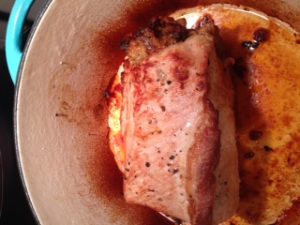Thanksgiving was a small affair this year, just Peg (the blog’s namesake) and me. Ordinarily I’d have helped out with a pie or something, but I did the whole shebang today. Turkey, mashed potatoes, stuffing, gravy, roasted brussels sprouts, cranberry sauce, and pecan pie. All very straightforward, most I’ve done before, but I managed to pull it all together, mostly on time.
The turkey was a 12 pound Jenny-O, roasted according to the package instructions (325F for about 3 hours and a bit).
Four potatoes (about 1.5# were peeled, roughly cubed, and boiled until done (tender by fork and tasted “done”) with 2 T of butter and a splash of milk.
I cheated on the stuffing and got Pepperidge Farm Country Style, which is really easy and really good. That was prepared with 4T butter, one can of chicken broth, and about a teaspoon of dried onion. Melted the butter, heated the broth, mixed in the stuffing, and put it all in a casserole which went into the oven a few minutes before the turkey came out.
Brussels sprouts I made according to a recipe I found here( and of course I bookmarked it!). I did eliminate the garlic because it’s not Peg’s favorite. This turned out great, by the way!
The pecan pie was made according to the classic Karo Syrup recipe which turns out to be the “family secret” after years of everybody raving over my Aunt Glenna’s Pecan Pie. I did forget to include the butter, but it turned out great just the same, making me think the butter isn’t really needed. The pie shell stuck in the Fiestaware pie plate though, so next time it will get sprayed. It doesn’t matter, but I used the dark syrup. The web site says either will do, and I’ve used both to good effect in past years (and of course I claim the recipe is a “family secret”).
Cranberry sauce? Ocean Spray, of course. What else could we serve in Massachusetts?
And the gravy was dead straightforward. There was about a cup of drippings in the turkey pan, with hardly any fat. I melted 2T of butter in a saucepan, added 3T of flour, and made a relatively dark roux, then added the drippings and one cup of milk, with a little salt and pepper, and cooked that until it was thickened a bit.
It turned out lovely.
Thanks and Happy Thanksgiving!
John

